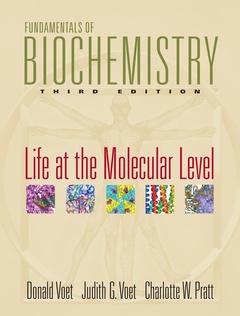Description
Fundamentals of Biochemistry : Life at the Molecular Level, 3rd Ed.
Author: VOET Donald
Language: English
Approximative price 217.63 €
Subject to availability at the publisher.
Add to cart1240 p. · Hardback
Description
/li>Contents
/li>Readership
/li>
Chapter 1. Introduction to the Chemistry of Life.
1.The Origin of Life
A.Biological Molecules Arose from Inorganic Materials
B.Complex Self replicating Systems Evolved from Simple Molecules
2.Cellular Architecture
A.Cells Evolved to Carry Out Metabolic Reactions
B.There Are Two Types of Cells: Prokaryotes and Eukaryotes
C.Molecular Data Reveal Three Evolutionary Domains of Organisms
D.Organisms Continue to Evolve
3.Thermodynamics
A.The First Law of Thermodynamics States that Energy Is Conserved
B.The Second Law of Thermodynamics States that Entropy Tends to Increase
C.The Free Energy Change Determines the Spontaneity of a Process
D.Free Energy Changes Can Be Calculated from Equilibrium Concentrations
E.Life Obeys the Laws of Thermodynamics
Box 1 1 Pathways of Discovery
Lynn Margulis and the Theory of Endosymbiosis
Box 1 2 Perspectives in Biochemistry
Biochemical Conventions
Chapter 2. Water.
1.Physical Properties of Water
A.Water Is a Polar Molecule
B.Hydrophilic Substances Dissolve in Water
C.The Hydrophobic Effect Causes Nonpolar Substances to Aggregate in Water
D.Water Moves by Osmosis and Solutes Move by Diffusion
2.Chemical Properties of Water
A.Water Ionizes to Form H+ and OH
B.Acids and Bases Alter the pH
C.Buffers Resist Changes in pH
Box 2 1 Biochemistry in Health and Disease
The Blood Buffering System
PART II: BIOMOLECULES.
Chapter 3. Nucleotides, Nucleic Acids, and Genetic Information.
1.Nucleotides
2.Introduction to Nucleic Acid Structure
A.Nucleic Acids Are Polymers of Nucleotides
B.The DNA Forms a Double Helix
C.RNA Is a Single Stranded Nucleic Acid
3.Overview of Nucleic Acid Function
A.DNA Carries Genetic Information
B.Genes Direct Protein Synthesis
4.Nucleic Acid Sequencing
A.Restriction Endonucleases Cleave DNA at Specific Sequences
B.Electrophoresis Separates Nucleic Acids According to Size
C.DNA Is Sequenced by the Chain Terminator Method
D.Entire Genomes Have Been Sequenced
E.Evolution Results from Sequence Mutations
5.Manipulating DNA
A.Cloned DNA Is an Amplified Copy
B.DNA Libraries Are Collections of Cloned DNA
C.DNA Is Amplified by the Polymerase Chain Reaction
D.Recombinant DNA Technology Has Numerous Practical Applications
Box 3 1 Pathways of Discovery
Francis Collins and the Gene for Cystic Fibrosis
Box 3 2 Perspectives in Biochemistry
DNA Fingerprinting
Box 3 3 Perspectives in Biochemistry
Ethical Aspects of Recombinant DNA...




